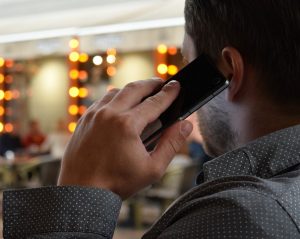Mobile phones are an indispensable part of modern life, but there are health concerns about the radiofrequency electromagnetic fields they generate. That’s why I’ve started using an R2L device to reduce cell phone radiation by 70%. Reducing exposure to cell phone radiation, using the tips below, may help to reduce your long-term risk of developing brain cancer.
Cell phones and radiation
The type of radiation emitted by cell phones is non-ionising, and similar to that of a low-powered microwave oven. These waves cause molecules to vibrate, an effect that gets stronger as you get closer to the phone. When you hold a cell phone to your ear, most of the energy released is absorbed by the skin and bone so only a small amount penetrated through to your brain during a call.
Researchers investigated the effects of cell phone radiofrequency on brain cells by placing a cell phone next to the left or right ear of 47 volunteers. A special scan (positron emission tomography) was then used to measure their brain cell metabolism when the phones were switched on, or off, for 50 minutes.
Although whole brain metabolism did not change when the cell phone was switched on, there was a definite effect on the metabolism of brain cells closest to the antenna (orbitofrontal cortex and temporal pole). These brain cells, which received a higher ‘dose’ of the radiofrequency signal became significantly more active (ie burned more glucose as fuel) when the phones were switched on compared to when they were switched off.
The effects of this artificial stimulation are still uncertain. According to the World Health Organization, no definite short-term adverse effects have been linked to the electromagnetic fields emitted from mobile phones, but the longer-term effects remain unclear.
Researchers are still investigating the possible effects of mobile phone electromagnetic frequencies on brain cell electrical activity, cognitive function, quality of sleep, heart rate and blood pressure. The main concern is with a possible increased risk of cell phone radiation cancer.
Cell phones and brain cancer
In the INTERPHONE study, which was carried out across 13 countries, phone use data from 2,708 people who developed glioma brain tumours, and 2,409 with meningiomas, were compared to phone use data from a group of similar people who did not have a brain tumour. Although researchers found no increase in the risk of brain tumours for most people, there was a suggestion of a higher risk for those with the highest exposure levels (top 10% for cumulative hours of cell phone use).
 Data from five of these countries (Australia, Canada, France, Israel and New Zealand) were then analysed further, and the location of the brain tumours taken into account. For gliomas in the part of the brain that was most exposed to radiofrequency fields during mobile phone use, there was a 2.8 fold greater association with extended mobile phone use (10 + years) compared with brain tumours in other locations.
Data from five of these countries (Australia, Canada, France, Israel and New Zealand) were then analysed further, and the location of the brain tumours taken into account. For gliomas in the part of the brain that was most exposed to radiofrequency fields during mobile phone use, there was a 2.8 fold greater association with extended mobile phone use (10 + years) compared with brain tumours in other locations.
Researchers then looked for links between mobile phones and the side of the head for which each person preferred to use their phone, and found that the risk of a tumour on the same side of the head increased by up to 100%.
Three meta-analyses of case-control studies have now concluded that using cell phones for more than ten years is associated with an increase in the overall risk of developing a brain tumour.
However, one criticism of these trials is that they rely on recall of past exposures, which is often inaccurate, and the incidence of brain tumours is not increasing exponentially which might be expected from the increased usage of mobile phones. The International Agency for Research on Cancer (IARC) have therefore classified the radiofrequency electromagnetic fields emitted by mobile phones as a ‘possible’ cause of cancer in humans, and have placed them in the same risk group (Group 2B) as lead, gasoline exhaust fumes and polychlorophenols.
How to reduce your risk of cell phone radiation cancer
Most of us couldn’t imagine life without our trusty cell phone. Although evidence of harm is not conclusive, it makes sense to limit your exposure to cell phone radiation as much as possible. This is especially important for children whose brains absorb up to 60% more radiation than an adult brain, because their skull is thinner. Children should only use mobile phones for essential purposes and keep all calls short.
 Select a low-emission model of mobile phone.
Select a low-emission model of mobile phone.- Limit the number of cell phone calls you make per day – send a text instead.
- Limit the length of each call.
- Avoid using your phone in a confined space such as a lift or train.
- Avoid using your phone if the signal strength is low – find a better location such as outdoors or closer to a window – when the signal from a base station is strong, the power output is up to 1000 times lower than when the signal is poor.
- Keep the phone (especially the aerial) as far as possible from your head – use the speakerphone or a wired earpiece to gain some distance – keeping it at least 15mm to 25mm from your body will reduce the amount of radiation absorbed
- When using a hands-free device, select one that is wired, rather than wireless
- Avoid touching the aerial while the phone is turned on
- Switch off your phone when not in use
- Avoid playing games on your mobile
- Don’t place the phone near your head when sleeping at night.
Use an R2L anti-radiation chip
I now use an R2L device which sticks to the back of my mobile phone to help reduce my risk of cell phone radiation cancer.
This passive microprocessor reduces the amount of radiation absorbed into my body without affecting the quality of calls.
 The R2L is an extraordinary device that absorbs excess radiation emitted by a cell phone through its antenna, and converts it into direct current electricity. This illuminates an LED light to disperse the energy as harmless light. You can actually see the R2L device working as it regularly emits a red pulse as it neutralises electromagnetic emissions.
The R2L is an extraordinary device that absorbs excess radiation emitted by a cell phone through its antenna, and converts it into direct current electricity. This illuminates an LED light to disperse the energy as harmless light. You can actually see the R2L device working as it regularly emits a red pulse as it neutralises electromagnetic emissions.
Independent testing at an accredited SAR (Specific Absorption Rate) facility shows that fitting the R2L device to a mobile phone reduces the level of electromagnetic energy absorbed into brain tissue by an impressive 70%.
Fitting an R2L to the back of your phone is an easy way to protect against the long-term effects of radiation. The R2L works with any mobile phones, tablets or laptops that use 3G and 4G service to connect to the internet.
My teenagers view their cell phones as a normal extension of their hand – even getting them to put phones away at meal times is a frequent challenge. I feel much happier now I know their phones are fitted with an R2L device.
The following video clip shows the results when a phone is tested with and without an R2L device fitted:



 Select a
Select a 


